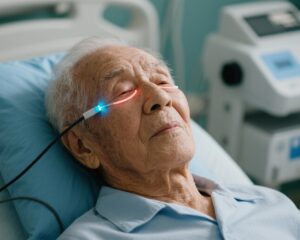Highlight
Nearly one-third of patients presenting with confirmed opioid overdose in emergency departments also exhibited benzodiazepine coexposure. Notably, novel benzodiazepines were associated with more than double the risk of requiring mechanical ventilation—an indicator of overdose severity—and showed increased rates of naloxone nonresponse compared to prescription benzodiazepines or no benzodiazepine exposure.
Study Background and Disease Burden
The opioid crisis remains a major public health challenge worldwide, with rising rates of overdose deaths attributed to potent synthetic opioids such as fentanyl and its analogs. Benzodiazepines, commonly prescribed for anxiety and sleep disorders, have increasingly been detected as co-substances in opioid-related overdoses, complicating clinical management. Emerging data suggest that newly identified or “novel” benzodiazepines—synthetic variants often found in illicit drug supplies—may exacerbate overdose severity due to potentiated central nervous system (CNS) depression when combined with opioids. Understanding this interaction and its impact on clinical outcomes is imperative to optimize emergency care and guide harm reduction strategies.
Study Design
This was a multicenter, prospective, observational study conducted from 2020 to 2023 involving 1427 adult patients with suspected acute opioid overdose presenting to emergency departments. Residual blood samples collected as part of routine clinical care were analyzed using liquid chromatography quadrupole time-of-flight mass spectrometry, allowing sensitive detection of over 1200 novel psychoactive substances, including novel benzodiazepines. Patients were stratified into three groups based on toxicology results: opioid exposure without benzodiazepine (n=1013), opioid exposure with prescription benzodiazepine coexposure (n=293), and opioid exposure with novel benzodiazepine coexposure (n=121).
The primary endpoint was severity of overdose operationalized by need for intubation and mechanical ventilation. Secondary endpoints included need for cardiopulmonary resuscitation (CPR), naloxone treatment parameters (initial and total dose, response rates, and infusion requirements), and incidence of coma/central nervous system depression within the first hour.
Key Findings
Patients coexposed to novel benzodiazepines were significantly more likely to require mechanical ventilation compared to those with no benzodiazepine exposure or prescription benzodiazepines (10.7% vs. 4.8% and 4.4%, respectively; adjusted odds ratio [aOR] 2.14; P=0.02). This finding underscores the greater clinical severity associated with novel benzodiazepine coexposure.
Naloxone nonresponse was markedly higher in the novel benzodiazepine group, occurring in 28.3% after the initial dose and 30.4% after all doses, compared to 20.5% and 25.6% in the prescription benzodiazepine group and 17.2% and 20.3% in the no benzodiazepine group (P=0.03 for both comparisons). Additionally, presence of novel benzodiazepines was associated with reduced odds of receiving a naloxone infusion (aOR 0.29; 95% CI, 0.09-0.73), reflecting altered therapeutic responses.
Coexposure to fentanyl independently elevated naloxone bolus dose requirements by 38% (adjusted rate ratio 1.38; 95% CI, 1.14-1.66), consistent with its potency and resistance to naloxone reversal.
Coma and central nervous system depression within the first hour were significantly more common in the novel benzodiazepine group (52.9%) than in the prescription benzodiazepine group (40.3%) or the opioid-only group (40.6%; P=0.03). Interestingly, CPR rates did not differ significantly across groups.
Expert Commentary
This study provides critical insight into the evolving dynamics of opioid overdoses complicated by novel benzodiazepines. The observed increase in mechanical ventilation and naloxone nonresponse highlight the intensified CNS depressant synergy in these coexposures. Given the rarity yet clinical significance of novel benzodiazepine detection, emergency clinicians should maintain heightened suspicion for these agents in refractory or unusually severe opioid overdoses.
Limitations include regional variability in illicit drug markets potentially affecting generalizability, reliance on discarded blood samples which may introduce selection bias, and the qualitative nature of toxicologic detection that limits dose-response correlation. Intubation as a surrogate for overdose severity may not capture nuanced clinical outcomes such as neurological sequelae or long-term morbidity.
Biologically, novel benzodiazepines may possess higher affinity or longer half-lives at GABA-A receptors compared to prescription agents, amplifying respiratory depression when combined with opioids. This interplay warrants further pharmacodynamic and clinical research to refine therapeutic algorithms.
Conclusion
The co-detection of novel benzodiazepines in confirmed opioid overdoses is an independent predictor of greater overdose severity, as evidenced by increased need for mechanical ventilation and higher naloxone treatment failure rates. Awareness of these synthetic benzodiazepines’ presence in the illicit drug supply is crucial for emergency providers, toxicologists, and public health policymakers. Enhanced toxicology screening and tailored treatment protocols may improve clinical outcomes. Future research should aim to quantify exposure levels, delineate specific agents contributing to severity, and develop strategies for rapid bedside identification and management.
References
Hughes A, Spungen H, Culbreth R, Aldy K, Krotulski A, Hendrickson RG, et al. Benzodiazepine Co-Exposure Among Patients Presenting to the Emergency Department With a Confirmed Opioid Overdose. Acad Emerg Med. 2025 Jul 15. doi:10.1111/acem.70104. Epub ahead of print. PMID: 40662447.
# Additional literature for context
Jones JD, Mogali S, Comer SD. Polydrug abuse: a review of opioid and benzodiazepine combination use. Drug Alcohol Depend. 2012 Aug 1;125(1-2):8-18. doi:10.1016/j.drugalcdep.2012.07.004.
Zvyaga T, et al. Emergence of Novel Benzodiazepines: Analytical Challenges and Clinical Implications. J Anal Toxicol. 2021;45(3):209-220.
AI-friendly visual prompt: “Emergency department clinicians managing a critically ill patient on a ventilator with highlighted chemical structures of opioids and novel benzodiazepines in the background”.


